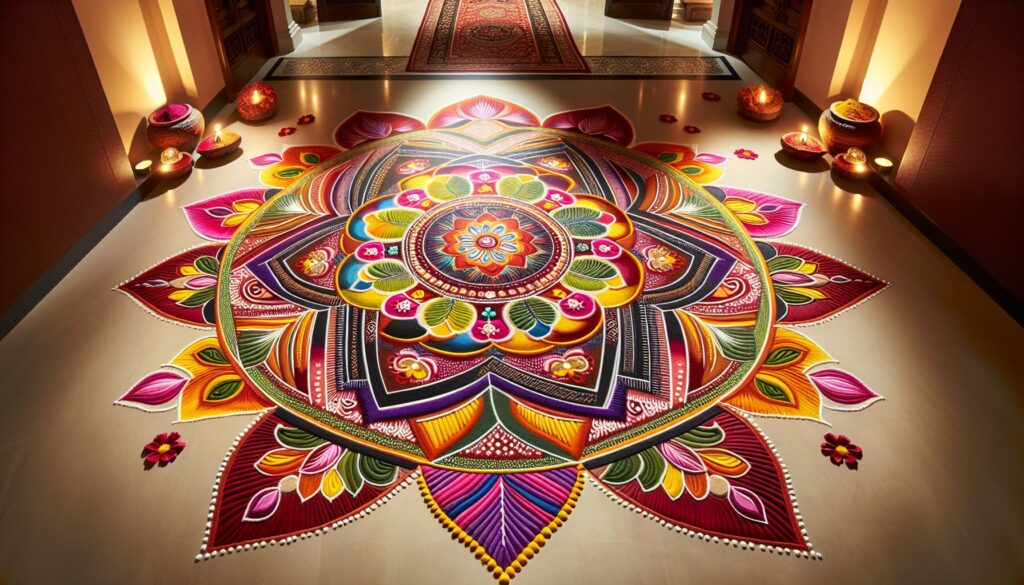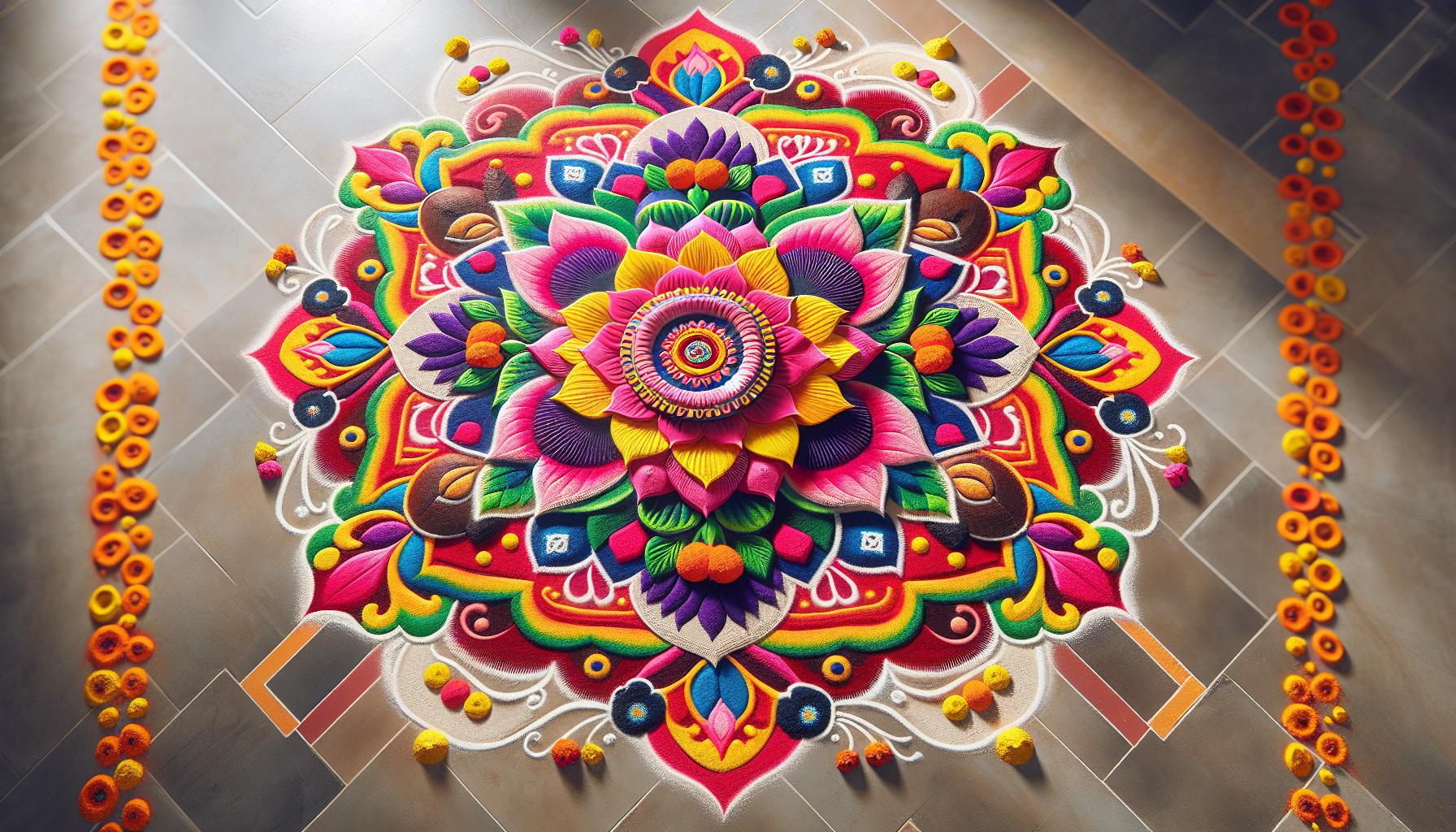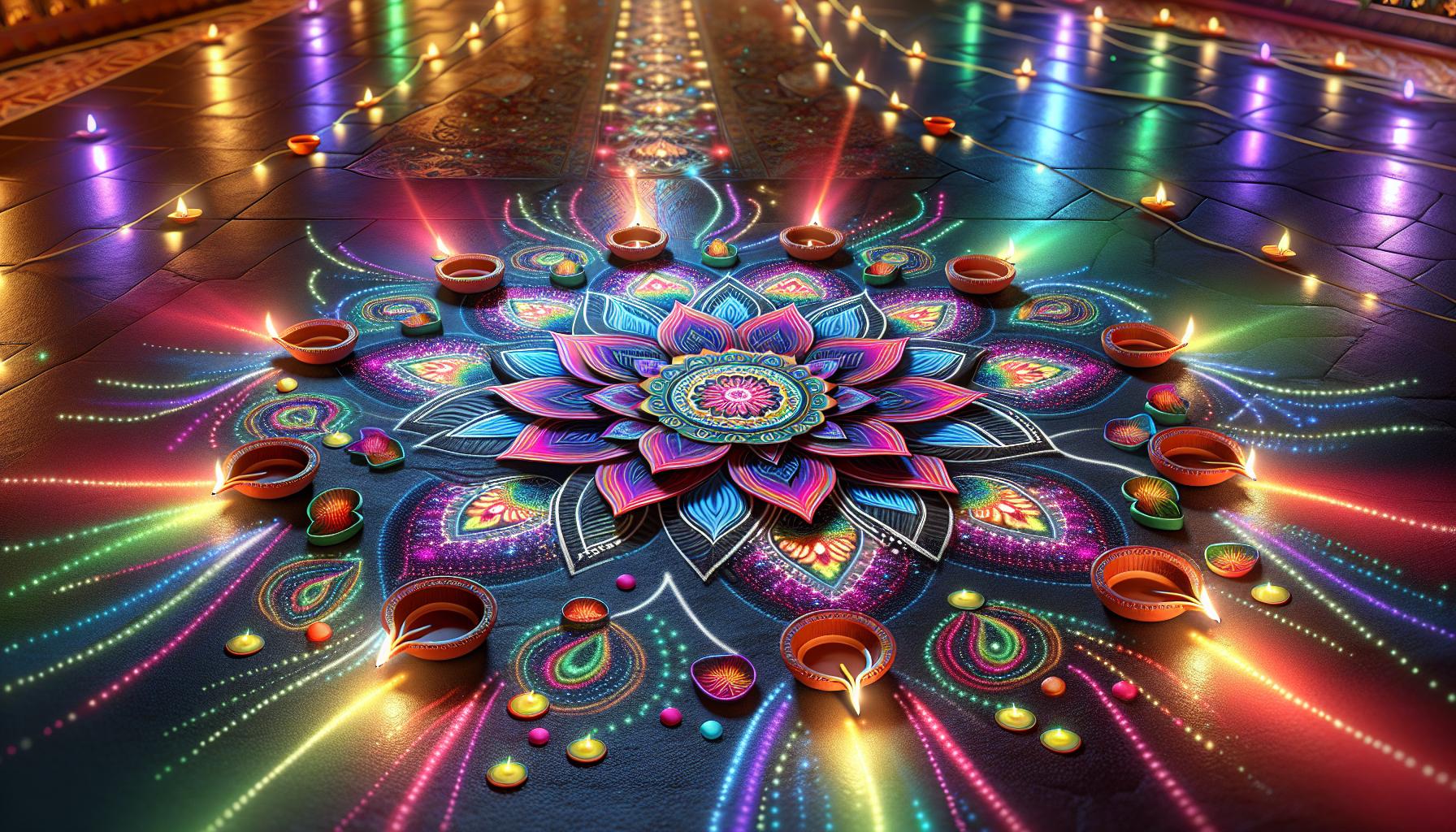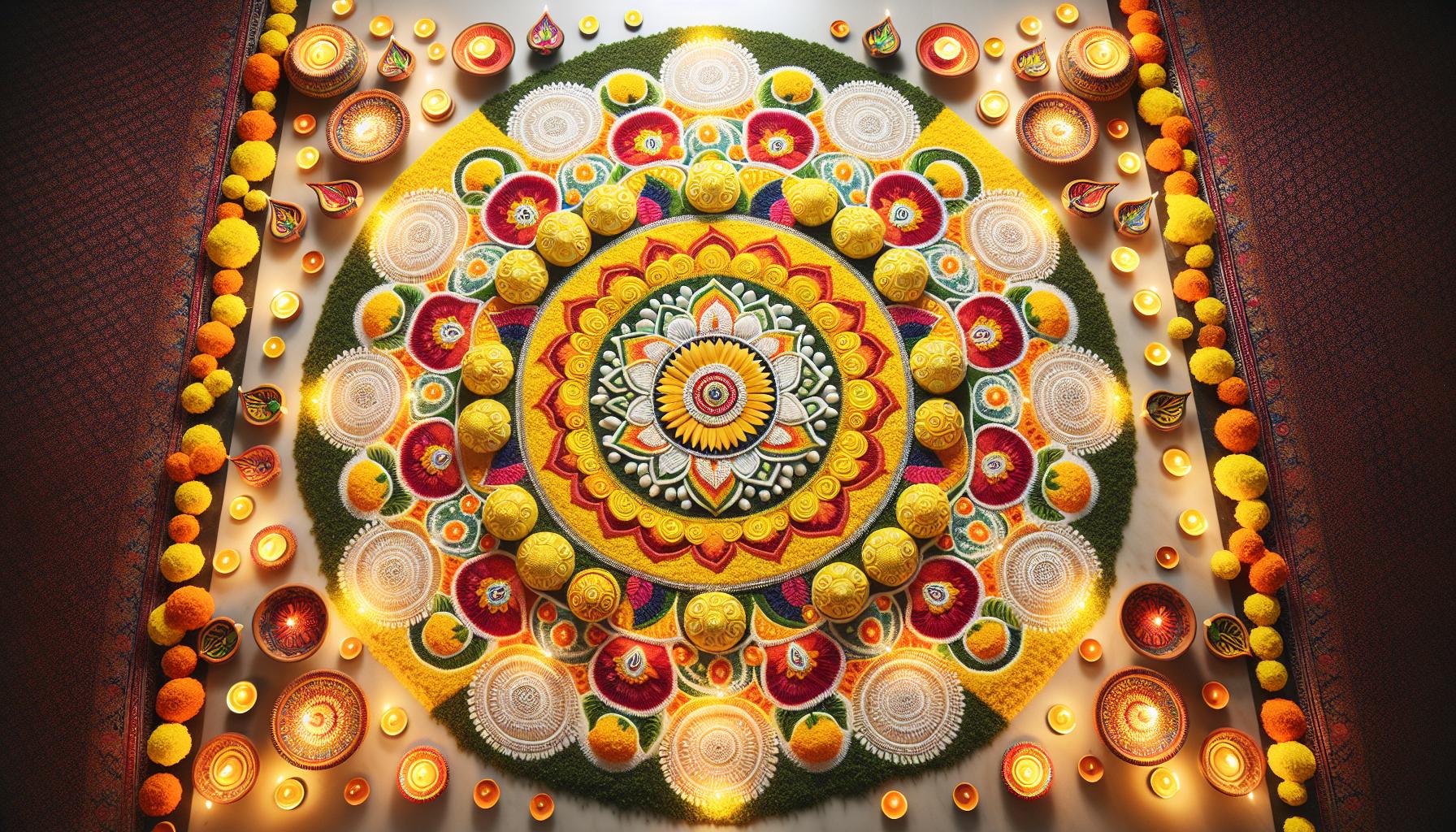
As Diwali approaches, I’m excited to explore the vibrant world of beautiful:8wkfaudfhbc= rangoli for Diwali. These intricate patterns, created with colored powders, rice, or flowers, are a hallmark of this joyous festival of lights. Rangoli not only adds beauty to our homes but also symbolizes good luck and welcomes the goddess Lakshmi.
I’ve always been fascinated by the artistry and creativity behind rangoli. From simple geometric shapes to elaborate depictions of deities, there’s a design for every skill level. In this article, I’ll share some stunning rangoli ideas that will brighten up your Diwali celebrations and impress your guests. Whether you’re a beginner or an experienced artist, you’ll find inspiration to create your own beautiful rangoli masterpiece.
Key Takeaways
- Rangoli is a traditional Indian art form that symbolizes good luck and welcomes Goddess Lakshmi during Diwali celebrations.
- Traditional rangoli designs often feature geometric patterns and floral motifs, while modern interpretations incorporate innovative materials and technology-inspired elements.
- Both natural and synthetic colors can be used to create rangoli, each offering unique benefits in terms of vibrancy, longevity, and eco-friendliness.
- Creating a stunning rangoli involves careful planning, strategic color layering, and attention to symmetry and balance.
- Preserving and displaying rangoli effectively can be achieved through sealing techniques, strategic lighting, and innovative presentation ideas.
Beautiful:8wkfaudfhbc= Rangoli for Diwali
Rangoli is a traditional Indian art form that involves creating intricate patterns on the floor using colored powders, rice, flower petals, or sand. It’s an essential part of Hindu festivals, particularly Diwali, where it serves both decorative and spiritual purposes.
The Cultural Significance of Rangoli in Diwali
Beautiful:8wkfaudfhbc= rangoli for Diwali holds deep cultural significance during Diwali, symbolizing prosperity, good luck, and divine blessings. It’s believed to invite positive energy and ward off evil spirits from entering homes. The colorful designs are typically created at the entrance of houses and in courtyards, welcoming guests and deities alike.
During Diwali, rangoli takes on special importance as it’s thought to guide Goddess Lakshmi into homes, bringing wealth and good fortune. The vibrant patterns and symmetrical designs reflect the joyous spirit of the festival, transforming ordinary spaces into sacred grounds for celebration.
I’ve observed that the creation of rangoli itself is a meditative practice, fostering a sense of community as family members often gather to create these ephemeral works of art together. This tradition not only beautifies the surroundings but also strengthens familial bonds and cultural identity during the festive season.
Traditional Rangoli Designs for Diwali
Traditional rangoli designs are the heart of Diwali decorations, embodying centuries of cultural heritage. These intricate patterns, created with colored powders, rice, or flower petals, serve as a visual feast and a spiritual invitation to prosperity and good fortune.
Geometric Patterns
Geometric patterns form the foundation of many traditional rangoli designs. These symmetrical shapes include circles, squares, triangles, and stars, often interlocked in complex arrangements. I’ve observed that concentric circles are particularly popular, symbolizing the cyclical nature of life and the universe. Straight lines intersecting at various angles create stunning mandala-like patterns, representing balance and harmony. For beginners, simple dot-grid designs offer an easy starting point, allowing for gradual complexity as skills improve.
Floral Motifs
Floral motifs in rangoli designs bring nature’s beauty to the doorstep. Lotus flowers, a symbol of purity and enlightenment, are a common centerpiece in many designs. I’ve seen intricate rose patterns, marigold-inspired borders, and stylized sunflowers adorning Diwali rangolis. These floral elements often incorporate swirling vines and leaves, creating a lush, organic feel. Petal-by-petal detailing showcases the artist’s patience and skill, while simpler, abstract floral shapes offer a modern twist on traditional designs. Many families use actual flower petals to create these motifs, adding fragrance and texture to the visual appeal.
Modern Interpretations of Diwali Rangoli
Modern rangoli designs for Diwali blend traditional elements with contemporary aesthetics, creating stunning visual displays. I’ve observed several innovative approaches that breathe new life into this age-old art form:
Fusion of Materials
Today’s rangoli artists experiment with unconventional materials:
- Glow-in-the-dark powders for nighttime illumination
- Metallic paints for a luxurious sheen
- Recycled materials like bottle caps or CDs for eco-friendly designs
- LED lights integrated into patterns for a dazzling effect
Abstract and Minimalist Designs
Modern rangoli often features:
- Simplified geometric shapes with bold color contrasts
- Asymmetrical patterns that challenge traditional symmetry
- Negative space utilization for striking visual impact
- Monochromatic color schemes for a sleek, contemporary look
Technology-Inspired Patterns
Rangoli designs now incorporate elements from the digital age:
- QR code-inspired patterns that actually scan
- Pixelated designs reminiscent of retro video games
- Circuit board layouts using colorful powders
- 3D-printed stencils for precise and intricate patterns
Cultural Fusion
Modern rangoli embraces global influences:
- Mandala-style designs infused with elements from other cultures
- Rangoli patterns inspired by famous artworks or pop culture icons
- Fusion of rangoli with other art forms like calligraphy or street art
- Incorporation of global symbols alongside traditional Indian motifs
Interactive and 3D Rangoli
Innovative artists create rangoli that engages viewers:
- 3D rangoli installations that rise from the floor
- Optical illusion designs that change appearance from different angles
- Interactive rangoli that invites participation from viewers
- Kinetic rangoli with moving parts activated by wind or touch
These modern interpretations maintain the spirit of Diwali while pushing the boundaries of traditional rangoli art. They showcase the adaptability of this ancient practice and its relevance in contemporary celebrations.
Materials Used in Creating Beautiful Rangoli
Creating stunning beautiful:8wkfaudfhbc= rangoli for Diwali requires a variety of materials. I’ll explore the essential components used in crafting these intricate patterns, focusing on both traditional and modern options.
Natural vs. Synthetic Colors
Natural colors for rangoli come from organic sources like turmeric, rice flour, and dried flowers. These eco-friendly options provide a traditional look and feel to the designs. Turmeric offers a vibrant yellow, while rice flour creates a crisp white base. Dried flower petals add texture and natural hues to the rangoli.
Synthetic colors, on the other hand, offer a wider range of vibrant shades. These artificial pigments come in powder form and are readily available in craft stores. They’re more long-lasting than natural colors and resist fading, making them ideal for outdoor rangoli designs that need to withstand weather conditions.
When choosing between natural and synthetic colors, consider:
- Environmental impact: Natural colors are biodegradable
- Availability: Synthetic colors offer more variety
- Longevity: Synthetic colors last longer
- Traditional value: Natural colors align with cultural practices
- Safety: Natural colors are non-toxic and skin-friendly
For a balanced approach, I often combine both natural and synthetic colors in my rangoli designs, leveraging the benefits of each type to create stunning visual effects.
Step-by-Step Guide to Making Rangoli
Creating a beautiful rangoli for Diwali doesn’t have to be daunting. I’ve broken down the process into simple steps that anyone can follow:
- Choose your design: Select a pattern that matches your skill level and available time. Simple geometric shapes or freehand designs work well for beginners.
- Gather materials: Collect colored powders, rice flour, flower petals, or sand. Ensure you have enough of each color to complete your design.
- Prepare the surface: Clean and dry the area where you’ll create your rangoli. A smooth, flat surface is ideal.
- Outline the design: Use chalk or light-colored powder to sketch the basic shape of your rangoli.
- Fill in the colors: Start from the center and work your way outward. Use a pinch of powder between your thumb and forefinger for precise application.
- Add details: Enhance your rangoli with intricate patterns, swirls, or dots using contrasting colors.
- Incorporate embellishments: Add diya lamps, flowers, or small figurines to elevate your design.
- Finish with a border: Create a distinct edge around your rangoli to frame it beautifully.
Remember, practice makes perfect. Start with simpler designs and gradually work your way up to more complex patterns as you gain confidence and skill.
Tips for Creating Stunning Diwali Rangoli Designs
Choose the Right Location
I always select a clean, flat surface near the entrance of my home for my Diwali rangoli. This prime spot ensures visibility and adheres to traditional placement. I sweep and mop the area thoroughly, allowing it to dry completely before starting my design.
Plan Your Design in Advance
Before I begin, I sketch my rangoli design on paper. This planning helps me visualize the final product and make necessary adjustments. I often use graph paper to create precise geometric patterns or trace intricate designs for more complex rangolis.
Start with a Simple Base
I begin by creating a simple dot grid or outline as the foundation of my rangoli. This base structure guides my design and helps maintain symmetry. For beginners, I recommend starting with a basic 5×5 or 7×7 dot grid and expanding from there.
Use the Right Tools
To achieve crisp lines and precise patterns, I use specialized rangoli tools:
- Funnels or squeeze bottles for fine lines
- Sieves for even powder distribution
- Small spoons for detailed work
- Thin paintbrushes for intricate designs
Layer Colors Strategically
I build my rangoli design by layering colors from light to dark. This technique creates depth and prevents darker colors from overshadowing lighter ones. I always keep a small brush handy to correct any mistakes or spills.
Incorporate Texture and Dimension
To add visual interest, I incorporate different textures:
- Rice or sand for raised patterns
- Flower petals for a 3D effect
- Mirrors or sequins for sparkle
- Diyas (oil lamps) for illumination
Practice Color Harmony
I select a harmonious color palette that complements my home’s decor. Traditional Diwali colors include:
| Color | Symbolism |
|---|---|
| Red | Purity and love |
| Yellow | Knowledge and peace |
| Green | Nature and harmony |
| Orange | Progress and success |
Maintain Symmetry and Balance
I constantly step back and view my rangoli from different angles to ensure symmetry. This perspective helps me maintain balance in the overall design and make necessary adjustments.
Add Final Touches
Once the main design is complete, I enhance my rangoli with:
- A decorative border
- Strategic placement of diyas
- Scattered flower petals
- Small figurines or idols
Protect Your Masterpiece
To preserve my rangoli, I gently spray it with a fixative or hairspray. This step helps the design withstand foot traffic and light breezes, ensuring it lasts throughout the Diwali celebrations.
Preserving and Displaying Your Rangoli Art
Creating a beautiful rangoli is just the beginning; preserving and displaying it effectively enhances its impact and longevity. Here are some techniques to ensure your rangoli remains vibrant throughout the Diwali celebrations:
Sealing the Design
To protect your rangoli from wind and foot traffic:
- Use a clear, non-toxic fixative spray
- Apply a thin layer of liquid hairspray
- Gently mist the design with a mixture of water and white glue
These methods create a protective barrier without altering the colors.
Lighting and Presentation
Enhance your rangoli’s visual appeal with strategic lighting:
- Place diyas or tea lights around the edges
- Use LED string lights to outline intricate patterns
- Position spotlights to highlight specific areas
Proper lighting not only showcases the design but also adds to the festive atmosphere.
Photography Tips
Capture your rangoli’s beauty for posterity:
- Use natural light for the best color representation
- Shoot from different angles to showcase intricate details
- Create a time-lapse video of the creation process
High-quality photos preserve the memory of your ephemeral art.
Maintenance During Diwali
Keep your rangoli looking fresh throughout the festival:
- Gently sweep away debris with a soft brush
- Touch up faded areas with fresh powder
- Protect from rain with a clear, removable covering
Regular maintenance ensures your rangoli remains a stunning centerpiece.
Innovative Display Ideas
Think beyond the traditional floor placement:
- Create a vertical rangoli on a large canvas
- Design a floating rangoli in a shallow water feature
- Incorporate rangoli patterns into wall hangings or tapestries
These unique displays add a contemporary twist to the traditional art form.
By implementing these preservation and display techniques, your rangoli will remain a captivating focal point throughout the Diwali festivities, impressing guests and honoring the rich tradition of this beautiful art form.
Meaningful Art
Rangoli is a vibrant and meaningful art form that brings beauty and spirituality to Diwali celebrations. I’m amazed by how this ancient tradition continues to evolve while retaining its core significance. Whether you choose traditional designs or modern interpretations the process of creating rangoli can be a meditative and bonding experience. With the right materials techniques and preservation methods you can create stunning designs that will delight your family and guests throughout the festival. I hope this guide inspires you to embrace the art of rangoli and make it a cherished part of your Diwali traditions.













